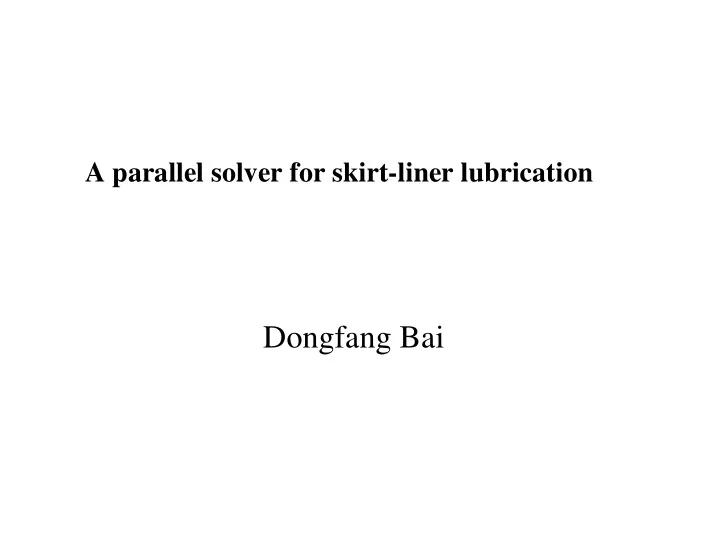

A parallel solver for skirt-liner lubrication Dongfang Bai
Overview of skirt-liner lubrication Pressure Force Oil Piston Sliding: Wrist 10m/s pin Cylinder Liner bore squeezing L z ~ 0.1m : 0.01m/s Connecting- Rod Exaggerated Piston Crankshaft L ~ 10 O microns • Characteristic of skirt-liner interface: Thin film lubrication!
Governing equation • Reynolds' Equation [ ∂ x ] = ∂ ∂ z ∂ z ∂ ∂ x ∂ z [ 2 ] ∂ h ρ ∂ ρ 3 ∂ p ρ 3 ∂ p ρ hW h h ∂ t 12 µ 12 µ • Limitation of Reynolds' equation: cavitation Reynolds' equation fails when cavitation happens. When pressure drops to cavitation pressure, fluid will cavitate and separate into liquid and vapor. Thus fluid pressure will not drop below cavitation pressure, which is not guaranteed in Reynolds' equation.
How to handle cavitation • JFO cavitation assumption Divide the computational domain into full film region and cavitation region. At full film region, use Reynolds' equation. At cavitation region, where there is partial film, assume pressure is constant and equals cavitation pressure, and assume the oil transport rate is determined by a linear velocity profile across the gap.
Algorithm overview • Finite volume method A mass conserving finite volume method is used to discretize the governing equations and formulate the algebraic equations. For each control volume P, the mass flux into it across its four control surfaces are represented using the information (including height, pressure, and state, that is, whether local node is full film or cavitation) of P and its four neighbors. This way, for each node, we get an algebraic equation based on mass conservation. • Using iterative method to handle cavitation
Parallel Implementation • PETSc The Portable, Extensible Toolkit for Scientific Computation (PETSc) is a suite of data structures and routines that provide the building blocks for the implementation of large-scale application codes on parallel (and serial) computers. PETSc uses the MPI standard for all message-passing communication. • Grid and parallel decomposition
Parallel Implementation • Use DA to help manage parallel communication DACreate2d(PETSC_COMM_WORLD,DA_NONPERIODIC,DA_STENCIL_STAR,Nx, Nz,PETSC_DECIDE,PETSC_DECIDE,1,1,PETSC_NULL,PETSC_NULL,&da); • Use MPI standard to communicate between processors Since each processor only have the local part of the overall information, when the information of 'ghost' points (the bordering portions of the grid that are owned by neighboring processes) are needed or need to be updated, MPI message is used.
Performance • Timing results on a quad-core computer: calculation time
Performance • Timing results on a quad-core computer: speed up
Performance • Timing results on a quad-core computer: parallel efficiency
Physical results • Comparison between the results of Reynolds' equation (cavitation not considered) and the results when cavitation is considered.
Physical results • Effect of surface tooling marks.
Physical results • Results for a real measurement.
Conclusion • Necessity of including cavitation is validated. • Parallel solver tested on a quad-core computer and good speed up is achieved. • Future improvement considering other parallel linear system solver.
Recommend
More recommend